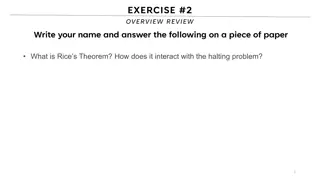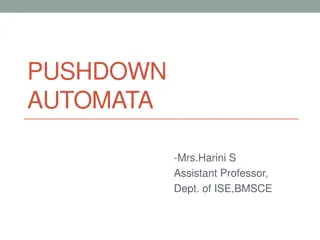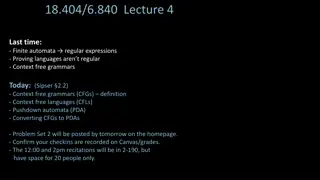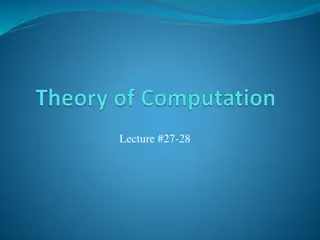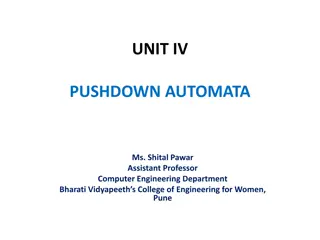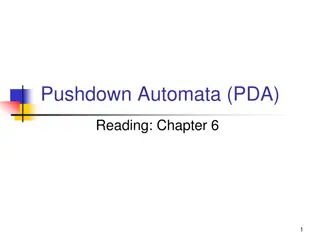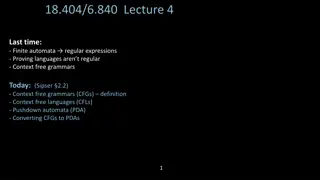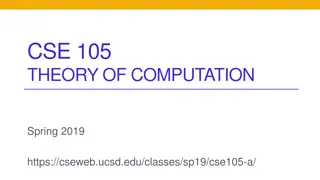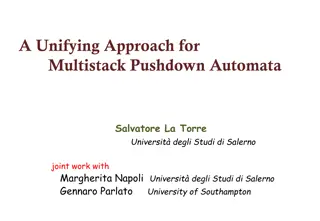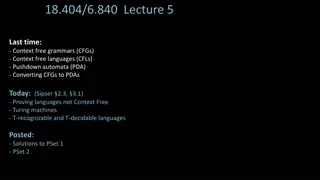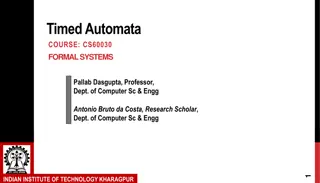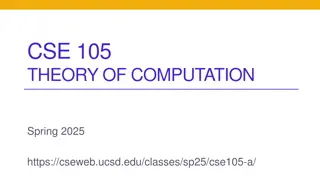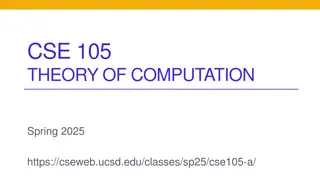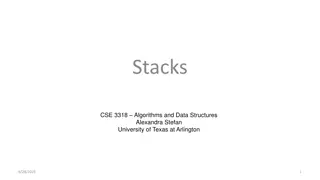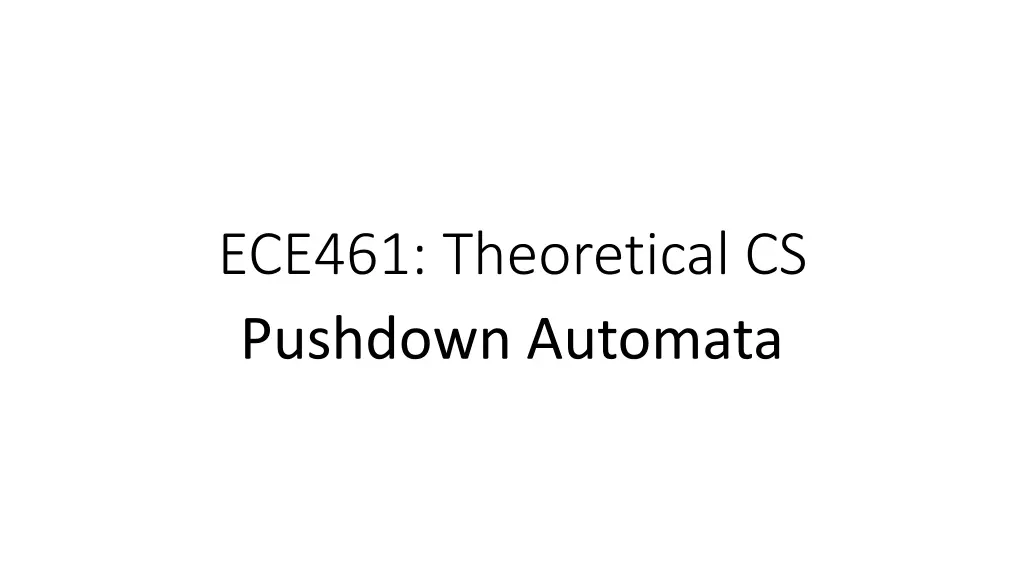
Understanding Pushdown Automata in Theoretical Computer Science
Dive into the world of pushdown automata, a formalism that extends the capabilities of regular languages using a stack. Learn how pushdown automata work, their transition functions, and their power in recognizing context-free languages.
Download Presentation

Please find below an Image/Link to download the presentation.
The content on the website is provided AS IS for your information and personal use only. It may not be sold, licensed, or shared on other websites without obtaining consent from the author. If you encounter any issues during the download, it is possible that the publisher has removed the file from their server.
You are allowed to download the files provided on this website for personal or commercial use, subject to the condition that they are used lawfully. All files are the property of their respective owners.
The content on the website is provided AS IS for your information and personal use only. It may not be sold, licensed, or shared on other websites without obtaining consent from the author.
E N D
Presentation Transcript
ECE461: Theoretical CS Pushdown Automata
Brief Recap In previous topics, we learned about three equally powerful formalisms capable of recognizing regular languages: Deterministic finite automata (DFAs) Nondeterministic finite automata (NFAs) Regular expressions (REs) We also discussed the pumping lemma for regular languages, which can be used to prove that certain languages are nonregular Then we learned about a more powerful formalism called context-free grammars (CFGs) CFGs are capable of generating (or more generally, describing) the context-free languages (CFLs), which includes all regular languages but also some nonregular languages In this topic, we will learn about another formalism called the pushdown automaton (PDA) Pushdown automata are equal in power to CFGs This topic is based on Section 2.2 of the textbook
Pushdown Automata Pushdown automata "are like nondeterministic finite automata but have an extra component called a stack" With each transition, a pushdown automaton can optionally pop one symbol from the top of the stack and/or push one symbol to the top of the stack The transition function of a pushdown automaton is optionally conditioned on the symbol at the top of the stack, as well as the current state and current input symbol If a stack symbol is specified as part of the input to the transition function, and that transition is applied, the symbol must be popped from the stack The output of the transition function optionally specifies another stack symbol to push to the stack The alphabet for the stack can be different than the input alphabet PDAs are nondeterministic, meaning that zero, one, or multiple transitions can be specified for each (state, input symbol, stack symbol) 3-tuple The output of a transition function is a (state, stack symbol) pair The stack symbol for the input or output of the transition function can be If the input stack symbol is , this means that the transition only depends on the current state and current input symbol, and no stack symbol is popped from the stack when the transition is applied If the output stack symbol is , this means that no stack symbol is pushed onto the stack when the transition is applied
Formal Definition of a Pushdown Automaton A pushdown automaton is a 6-tuple (Q, , , , q0, F), where Q, , , and F are all finite sets, and: 1. Q is the set of states, 2. is the input alphabet, 3. is the stack alphabet, 4. : Q P(Q ) is the transition function, 5. q0 Q is the start state, and 6. F Q is the set of accept states. Recall that and represent { } and { }, respectively, and P(Q ) is the power set of the result of a Cartesian product
Computation with a PDA Consider some pushdown automaton M = (Q, , , , q0, F), as defined on the previous slide We say that M accepts input w = w1w2 wm, where each wi , under the following circumstances: There exists a sequence of states r0, r1, , rm, where each rm Q, and There exists a sequence of strings (representing the stack contents) s0, s1, , sm, where each sm *, and The following constraints are satisfied: r0= q0and s0= (i.e., M starts at the initial state with an empty stack) For each i = 0, 1, , m-1, it is the case that (ri+1, b) (ri, wi+1, a), where si= at and si+1= bt and a, b and t * (i.e., every transition is a valid transition) rm F (i.e., M reaches a final state at the end of the input) Although this may seem straight-forward (once you carefully interpret all the symbols), there is one point that I was originally confused about According to the above notation, it is clear that M cannot stay at an accept state without processing all its input (the same is true for DFAs and NFAs, and I am confident that this is correct) However, if M reaches an accept state at the end of the input, and there are outgoing transitions that do not process input but pop a stack symbol, s, and s it at the top of the stack, can M ignore such transitions? According to this definition, the input would be accepted, meaning that such transitions can be ignored I believe this is correct; transitions (such as -transitions) are not forced, but all input must be processed
Deterministic Pushdown Automata Earlier in the course, we saw (and proved) that DFAs and NFAs are equal in power Later in the course, we will see that deterministic and nondeterministic Turing machines are equal in power However, deterministic and nondeterministic pushdown automata are not equal in power Deterministic pushdown automata (DPDAs) recognize a class of languages called deterministic context-free languages (DCFLs) DCFLs fall in between regular languages and context-free languages DPDAs and DCFLs are discussed in Section 2.4 of the 3rdedition of the textbook, but we will not cover this topic in the course
Pushdown Automaton Example 1 The next slide gives a description matching our formal definition for a pushdown automaton that recognizes the language {0n1n| n 0} Recall that in previous topics, we proved this language to be nonregular, but we saw that it is context free, because a CFG can generate it A PDA that recognizes this language can work as follows (this is a high-level description for now) It starts with an empty stack (all pushdown automata do), and it proceeds to read its input As each 0 is read, it is pushed onto the stack When each 1 is read, the top 0 from the stack is popped If the input ends at the same step that the last 0 is popped, the machine accepts If the stack becomes empty before the input ends, or if the input ends when the stack is nonempty, or if any 0s occur after the first 1, the machine rejects The next slide specifies such a PDA more formally
Formal Description of PDA Example 1 We will construct a pushdown automaton M1= (Q, , , , q1, F) that recognizes the language {0n1n| n 0} as follows: 1. Q = {q1, q2, q3, q4}, 2. = {0, 1}, 3. = {0, $}, 4. can described as follows, where blank entries represent (the chart was copied from the book): q1is the start state, F = {q1, q4} (q1is one of the final states so that the empty string is accepted) Note that we need the $ as an additional stack symbol to give the machine a way to recognize when the stack becomes empty; this is a useful trick 5. 6.
State Diagrams for Pushdown Automata As with DFAs and NFAs, PDAs can be represented graphically using state diagrams IMO, this is much more readable than the formal description of a PDA The next slide shows a state diagram for M1, the PDA represented formally on the previous slide Each transition arrow is labeled using the format "a, b c" Here, a represents the input symbol, b represents the symbol popped from the stack, and c represents the symbol pushed onto the stack Of course, the source and destination states are labeled in the nodes at the source and destination of the transition arrow Any of the three components of the label can be If a is , it means that no input is read when using this transition If b is , no symbol is read or popped from the top of the stack If c is , no symbol is pushed onto the stack
Pushdown Automaton Example 2 The next slide shows a state diagram for a pushdown automaton that recognizes the language {aibjck| i, j, k 0 and i = j or i = k} Informally, we can say that the PDA works as follows: First, it pushes all the a's to the stack Then, it relies on nondeterminism to try out two things in parallel In one branch, it checks if the number of b's matches the number of a's In another branch, it skips the b's and checks if the number of c's matches the number of a's Note that we once again use the trick with the extra $ symbol to recognize when the stack is empty Also, we don't have to explicitly check for symbols appearing out of order This is because paths being explored by the machine will end if there is no transition specified for the next input symbol (i.e., if the output of the transition function is )
Pushdown Automaton Example 3 The next slide shows a state diagram for a pushdown automaton that recognizes the language {wwR| w {0, 1}*} Recall that wRrepresents the reverse of string w (the string with the same symbols in the opposite order) Informally, we can say that the PDA works as follows: It starts reading symbols from the input, and pushes the same symbols onto the stack Nondeterministically, at any point, it can "guess" that it is at the halfway point The way I like to think about it, each guess starts a parallel path of computation For each such path, it reads the remaining input symbols, continuing as long as the next input symbol matches the symbol at the top of the stack, which is popped If the input is fully processed at the point when the stack becomes empty, the input is accepted; otherwise, it is rejected Remember that if any path accepts the input, then the PDA accepts the input; if every path rejects the input, the PDA rejects the input
PDAs and CFGs are Equal in Power As mentioned earlier, the two formalisms of CFGs and PDAs are equal in power Theorem 2.20 in the textbook thus states: "A language is context free if and only if some pushdown automaton recognizes it" To prove this, we need to show two things, neither of which is simple One of these two things is stated in Lemma 2.21: "If a language is context free, then some pushdown automaton recognizes it" To prove this, we will show that any CFG can be converted into an equivalent PDA Later, Lemma 2.27 states: "If a pushdown automaton recognizes some language, then it is context free" To prove this, we will show that any PDA can be converted into an equivalent CFG Although I created slides for these two proofs, we will probably not cover these proofs in complete detail in class (to save time) Both proofs are explained in the textbook, and I will at least try to provide some of the intuition behind them
Every CFG has an Equivalent PDA We know that for every CFL, A, there is a CFG, G, that generates it We will now discuss how to convert G into an equivalent PDA, P, that recognizes A P therefore accepts an input string, w, if and only if w can be derived from G's start symbol Each step of the derivation results in a sequence of nonterminals and terminals, which we will call an intermediate string Book: "We design P to determine whether some series of substitutions using the rules of G can lead from the start variable to w" Since there will often be multiple substitutions allowed, we will make use of nondeterminism The PDA's stack contains the symbols of the intermediate string that have not yet matched input symbols Symbols are pushed in an order such that the left-most remaining symbol in the intermediate string is at the top of the stack The figure on the next slide helps to explain this; I add: In the figure, the start symbol has been used to derive the intermediate string 01A1A0 The first two symbols of the input string, 01, have already been matched The machine will ultimately accept the input, 011001, if and only if the remainder of the intermediate string, A1A0, can derive the remainder of the input, 1001 (clearly this will not be possible in this case)
Pushing a String onto the Stack The steps of the solution we will discuss assume that we can push an entire string to the stack Since a PDA cannot do this in a single step (at least, not as PDAs are defined in our textbook some other sources describing PDAs allow it), we need to do this using multiple steps To do so will require creating additional states for every single transition rule We can describe how to do this with an example (the figure on the next slide helps to explain it): Suppose we are in state q, the next input symbol is a, and the top of the stack contains s The desired transition would read the input a, pop s (transitions are always required to pop the matching stack symbol), jump to state r, and push the string xyz onto the stack (with z toward the bottom of the stack and x at the top of the stack) We can do this in three steps, one for each symbol of the string we want to push The first step will read the input symbol a, pop s, and push z; we will jump to a state called q1, only for use with this particular, desired transition rule The next step will not read any input or pop anything; it will just push y and jump to state q2 The final step will also not read any input or pop anything; it will just push x and jump to state r Now that this has been explained, we will present the steps of P (a PDA that simulates a CFG, G) as if a transition rule is allowed to push an entire string onto the stack We do this with the understanding that a formal description of P would implement every such transition rule with multiple steps, and additional states, as described above
The Description of P (somewhat informal) The state diagram of P, the PDA simulating a CFG, G, is shown on the next slide P starts in its initial state, qstart(with an empty stack, of course) Without reading any input, P jumps to state qloopand pushes the string S$ onto the stack This uses the process to push a string, as explained on the previous slide The $ is pushed first, so it will be at the bottom of the stack The symbol S (the start symbol of G) is pushed second, so it will be at the top of the stack Then the following steps are repeated continuously, as long as we are at state qloop If the top of the stack is a terminal symbol, and it matches the next input symbol, a, then pop a from the stack, and stay at the current state qloop If the top of the stack is a nonterminal (a.k.a. a variable), A, without considering input, nondeterministically push every string w for which A w is a rule of G, and stay at state qloop If the top of the stack contains $ (meaning we have completed a derivation starting from S), then jump to state qaccept A couple of additional things to point out are: It turns out that every transition that pushes a string does not depend on the input, so we are not even taking advantage of the full generality of the process explained on the previous two slides At state qloop, if the top of the stack contains a terminal that does not match the next input symbol, this nondeterministic path rejects the input (which does not necessarily mean P rejects the input, if some other nondeterministic path accepts it) Similarly, if we jump to qacceptwithout exhausting the full input string, this nondeterministic path rejects the input
CFG to PDA Example The next slide shows the resulting PDA when the process we have described is used to convert the following CFG: S aTb | b T Ta | Some things to point out: The diagram is showing the complete PDA, including the extra states when pushing strings to the stack The multi-transition sequences leading from qloopto qlooprelate to the rules S aTb and T Ta The curvy arrow really represents four separate transitions The top two labels relate to the rules S b and T The bottom two labels represent transitions that occur when the next symbol in the intermediate string matches the next input symbol
Every PDA has an Equivalent CFG Consider a PDA, P, that recognizes some language, A We will now discuss how to convert P into an equivalent CFG, G, that generates the same language, A, meaning that A is a CFL We need to design a grammar that can generate a string, w, if and only if P accepts w, meaning that w takes P from its start state to one of its accept states As the textbook explains, we will "design a grammar that does somewhat more" We will design a grammar, G, such that for each pair of states p and q in P, G has a variable Apqthat generates all strings that take P from p with an empty stack to q with an empty stack Of course, strings that take P from p with an empty stack to q with an empty stack would also take P from p to q, more generally, leaving the stack contents in the same state as it started Before the conversion, we modify P to ensure the following properties: P has a single accept state, qaccept P empties its stack before accepting Every transition either pushes a symbol onto the stack or pops a symbol from the stack, but not both The textbook doesn't even explain how to achieve the first two properties, claiming that they are "easy"; I might agree, but I think that the second property warrants discussion (I'll discuss it in class if we cover the proof in detail) The next slide discusses how we can achieve the third property
Modifying P to Meet the Third Constraint Assume we have a PDA, P, that already achieves the first two constraints (the so-called "easy" ones) listed on the previous slide We can then achieve the third constraint as follows: For every transition that neither pushes or pops a symbol, convert it to two transitions The first transition processes its input symbol and pushes an arbitrary symbol to the stack The second transition does not process input and pops the symbol that the previous transition pushed For every transition that both pushes and pops a symbol, convert it to two transitions The first transition processes its input symbol and pushes the appropriate symbol The second transition does not process input and pops the appropriate symbol
How to Get from p to q with an Empty Stack? Consider a nonterminal, Apq, in a CFG, G, which generates all strings that bring PDA, P, from state p to state q with an empty stack The path that P takes must start with a push and end with a pop (due to the constraints satisfied by P) Either the symbol popped from the stack in the last step is the symbol pushed to the stack during the first step, or it is not; we will consider both possibilities If the two symbols are the identical, this means that as the first input symbol is read, a stack symbol is pushed to the stack, and as the last input symbol is read, the same stack symbol is popped form the stack We simulate this possibility by adding the following rule to G: Apq aArsb Here, a is the input symbol read at the first step, and b is the input symbol read at the last step Also, r represents the state following p and s represents the state preceding q If the two symbols are not identical, this means that the symbol pushed to the stack during the first step is popped from the stack at some point before the end of the sequence We simulate this possibility in G by adding the following rule: Apq AprArq Here, r represents a state where the stack becomes empty on the path from p to q Note that there might be multiple rules (and rules of both types) generated for a pair of states (p, q), representing different paths from p to q that start and end with an empty stack The figures on the next slide help to explain how these rules simulate computation performed by P
Converting a PDA to a CFG We can now put all the pieces together and convert a PDA to a CFG Suppose P = (Q, , , , q0, {qaccept}) is a PDA that adheres to the three extra constraints, as already explained We can construct a CFG, G, that generates the same language that P accepts as follows: For each p, q, r, s Q, u , and a, b for which (r, u) (p, a, ) and (q, ) (s, b, u), add the substitution rule Apq aArsb to G For each p, q, r Q, add the rule Apq AprArqto G For each p Q, add the rule App to G (this rule indicates that the empty string can take P from state p to state p with an empty stack) The book steps through two additional inductive proofs showing: If Apqgenerates x, then x can bring P from p with an empty stack to q with an empty stack If x can bring P from p with an empty stack to q with an empty stack, Apqgenerates x We are not going to step through these proofs, but if you've carefully followed everything so far, the proofs basically just rely on things that we have already explained Set Aq0qacceptto be the start symbol of G Recall that if P accepts w at all, it can accept w with an empty stack, due to the imposed constraints Then, G generates a string, w, if and only if w brings P from q0to qaccept(i.e., if P accepts w)
Regular Languages (re-re-re-revisited) In our previous topic (which covered CFGs), we casually discussed a proof that all regular languages are context free Now, we have a much simpler way to prove this All DFAs (and more generally, all NFAs) are also valid PDAs, because a PDA is allowed to ignore its stack We now know that PDAs can be converted to CFGs By definition, every regular language has a DFA that recognizes it Therefore, every regular language has a PDA that recognizes it Therefore, every regular language has a CFG that generates it Hence, every regular language is context free We have also seen that the context-free languages include some nonregular languages Therefore, the regular languages are a proper subset of the context-free languages

